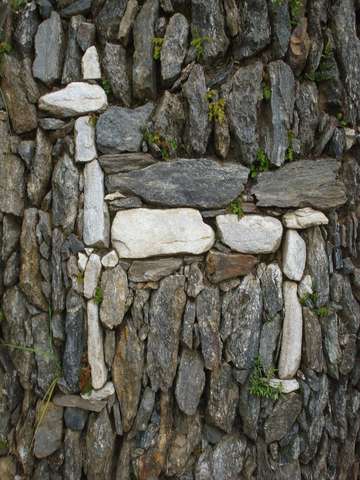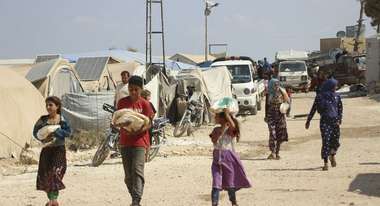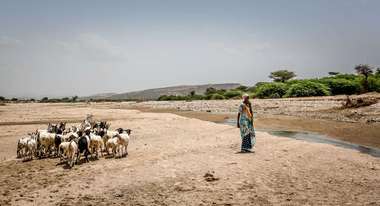Andean Alpacas Defy Mining and Climate Change. But for How Much Longer?
The FAO has declared 2024 the Year of Camelids. They ensure the survival of poor families in inhospitable parts of the world. But in South America, alpacas and farming families are under threat.
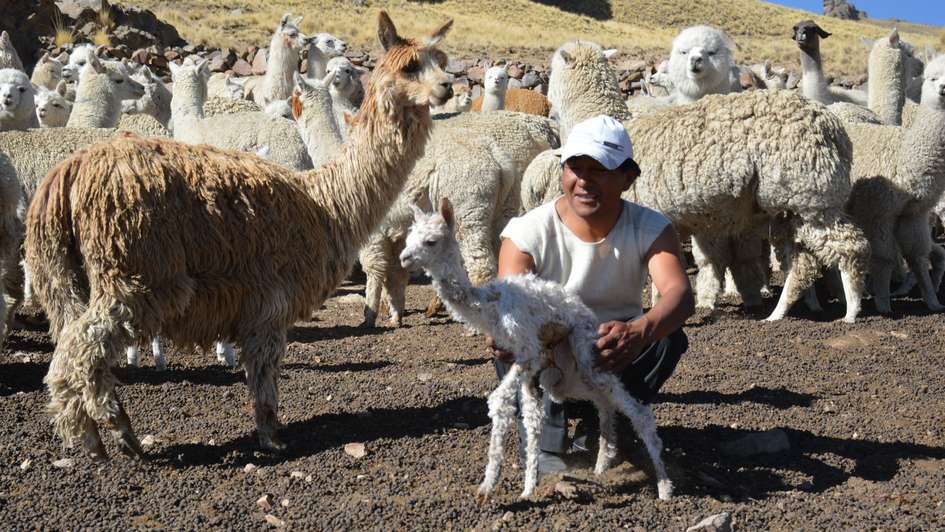
It is an inhospitable place to give birth: At an altitude of 4000 meters, the air is as thin and clear as glass. The sun does not warm. It burns. And as soon as it sets, it gets freezing cold. But the little white alpaca foal born on this night in the Peruvian Andes already sports a thick woolly coat. It is drinking its mother's milk with a determined pull and is still stumbling awkwardly on long legs through the corral that alpaca breeder Abelino Sahuinco has built out of stones – as did his father and grandfather before him.
He is pleased: The foal is healthy and its mother is also doing well. These days, that is no longer a matter of course. For safety reasons, the foal will remain in the corral with the mother herd for a few more days until it is quick enough to escape a puma. Then the herd is released. Together with a few herding dogs and a shepherd, they move across the barren plateaus of the Andes in search of food – not far from the small town of El Espinar. Until that time comes, Sahuinco has to feed the animals and carry water into the corral. It is back-breaking work, but Sahuinco is not complaining. Camelids are not folklore in the Andes; life without them is simply unimaginable.
Camelids provide meat and milk. Their dung fertilizes pastures and serves as fuel. The sensitive soils of the Andean moors are less badly affected by their cloven hooves than by those of cows. That makes them more environmentally friendly. They need relatively little water and are ideal pack animals. Their cosy wool is traditionally used to weave cloaks and blankets. Many of the patterns are based on ancient indigenous traditions. Andean camelids were already sacred to the Incas. In the ruins of the ancient Inca city of Choquequirao, for example, vicuña silhouettes (see box) are carved into terraced walls.
Symbiosis is Under Threat
But the idyllic image of the baby alpaca with the wreath of long lashes encircling its huge, black eyes is deceptive: The centuries-old symbiosis that allowed humans and animals to survive in this rather inhospitable ecosystem is under threat. “My grandfather's pastures used to be there,” says Sahuinco, pointing pensively to a huge mine dump in the valley. Trucks dump tons of rock there by the minute – waste from the nearby copper mines of Tintaya and Antapaccay. Both belong to the Swiss mining group Glencore.
Glencore operates open-cast mines in the region. Everything is gigantic in this industry – the quantities, the dimensions, the finance. Entire mountains are processed to extract the mineral treasures they contain. First the rock is blasted, then copper, gold, zinc, molybdenum and rare earths are extracted using millions of liters of water and poisonous substances such as cyanide. The waste rock piles up elsewhere and toxic silt is stored in tailing dams. The valuable minerals are exported and processed in Europe.
Mining Changes Lives
For local residents, open-cast mining was a brutal disruption of their peaceful lives. Detonations now break the silence. Heavy trucks transport metal concentrate or fuel along the only road connecting the Andes and the coast. Since then, El Espinar has been covered by a permanent haze of dust. According to medical examinations, heavy metals have accumulated in the air, water, soil and even in the blood of local residents. The company and regional politicians deny these consequences – to the chagrin of the farmers. “My alpacas are losing their fur, many mares have miscarriages or give birth to deformed foals,” Sahuinco reports.
Who is Who? The Camelids of the Andes
- Llamas are the largest camelids in the Andes and, like all the others, herd animals. They are mainly used as pack animals, but also as a source of meat. They are wary and nervous and tend to spit if feeling harassed.
- Guanacos are the wild ancestors of llamas and the second largest species of the family. Their top coat is light brown with a gray belly and head. Their wool is thick and rough. They get by with little water and are often found in arid regions such as Patagonia or the Atacama Desert in Chile.
- Alpacas are the domesticated cuddly toy version of the Andean camel species. Their heads are shorter and covered with more wool, and their fur is finer, fluffier and softer than that of llamas. They are often unicolored, with white predominating. They are considered frugal and are mainly bred for their wool.
- Vicuñas are probably the wild form of alpacas. They were revered by the Incas and are characterized by a deer-shaped, slender body. Their wool is the most expensive and most sought-after on the market. This is why their numbers are severely depleted. Hunting them is now prohibited, but traditional communities are allowed to capture and shear a certain number of animals each year.
For him, this has serious consequences, as the wool from his 100 alpacas is his major source of income. He receives 20 dollars per animal shorn; shearing is possible once a year. Peru is the global market leader in the export of alpaca wool products. The country has four million registered alpacas, 87 percent of the global population. Almost 80 percent of all alpaca products worldwide come from the Andean country, 120’000 families make a living in this industry which contributes almost one billion dollars to the gross domestic product annually.
Sustainable Industry
An advantage of the alpaca industry is that it is labor-intensive and controlled by Peruvian family businesses. The added value is not generated elsewhere – as is the case with mining – but directly in Peru. The industry is also quite sustainable and uses hardly any chemicals along the entire supply chain. Even the dyes used for wool garments are mostly of natural origin. Almost all parts of the animal are utilized. Most sought-after is the fine wool on their back, known as baby alpaca. Less high-quality wool, mainly from the legs, is turned into carpets or bags. If treated carefully, alpaca clothing lasts a lifetime. Often, it is also seen as a commitment to quality – and against environmentally harmful fast fashion.
Das Zentrum der Verarbeitung der Wolle liegt in Arequipa im Süden des Landes. Dort haben die beiden dominierenden Familienkonzerne, Michell und Incatops, zahlreiche Spinnereien sowie ein Alpaka-Museum und ein Alpaka-Forschungslabor eingerichtet. Die beiden Konglomerate sind inzwischen vertikal integrierte Unternehmen, die Wolle aufkaufen, spinnen und selbst Kleider entwerfen und vermarkten. Bei diesem Duopol bleibt der Großteil der Gewinne hängen. Sie verkaufen auch hochwertige Wollfäden an internationale Luxusmarken wie Prada oder Max Mara und zunehmend auch nach China. In New York oder Paris kostet ein Alpaka-Wollrock vom Luxusdesigner gute 500 bis 800 Dollar.
In addition, several local fashion designers in Arequipa, Cusco and the capital Lima have gained an international reputation. Brands such as Anntarah and Escvdo have dressed celebrities like Katy Perry. Even if a garment is not from a designer label, the retail price is high in relation to the cost of the raw materials: An alpaca sweater from a local designer sells for the equivalent of 100 dollars. Some of these labels have close business relationships with very specific communities from whom they buy their wool at a higher price.
While they know that the quality of the end product stands and falls with the raw material, it is becoming increasingly difficult for farmers in the highlands to maintain their herds. It is not only the environmental pollution from conventional open-cast mining that is becoming a threat. Lithium mines pose a new danger. International corporations are mining the mineral, which is important for electromobility and smartphones, primarily in the lithium triangle between Bolivia, Argentina and Chile. This requires fresh water – an extremely scarce resource in the upper Andes. Due to strong solar radiation, between 7 and 20 times more water evaporates than it rains. “Between 80 and 90 percent of the water in the upper Andes is underground, and these basins are connected to each other like veins,” explains Patricia Marconi, a biologist and president of the Argentinian Yuchan Foundation. Due to the underground linkage, if you utilize the water in one place, the consequences are often felt elsewhere.
This is the case in the Salt Lake of Hombre Muerto in northern Argentina. US company Livent operates a plant here from which German car manufacturer BMW, among others, obtains lithium for electric car batteries. Around half a million liters of brine are evaporated to produce one ton of lithium carbonate. A further 46’700 liters of fresh water are required for processing. Livent extracts groundwater for this purpose. A few years ago, the Trapiche River, an important source of water for the herds of farming families, ran dry within the catchment area of the factory.
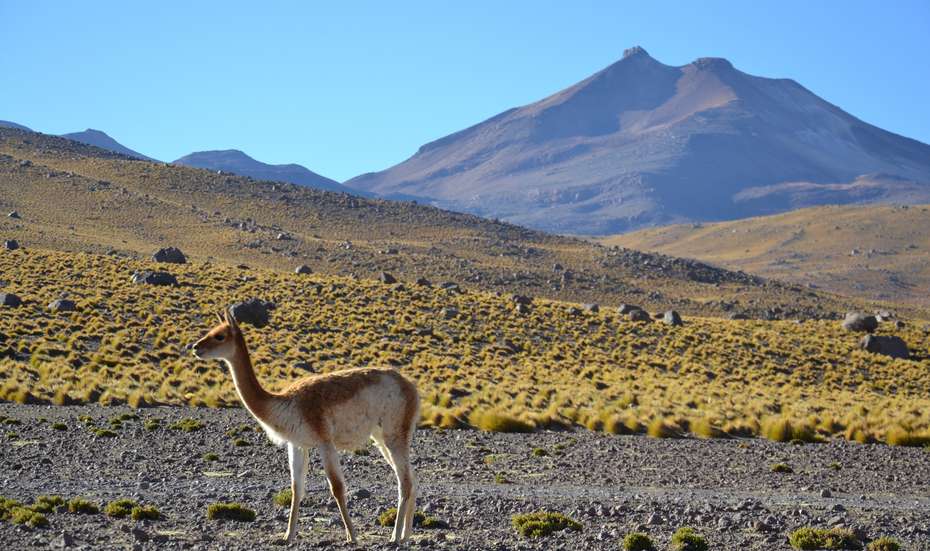
Herds Suffer from Lithium Mining and Climate Change
The Condori family, who live in the immediate vicinity of the Salar del Hombre Muerto, recently complained to journalist Analia Llorente about the increasingly difficult conditions. The well and a meadow behind their house dried up after the factory was commissioned. As a result, they have had to sell most of their cattle and alpacas. “We can no longer make a living from selling wool and meat,” says Nico Condori. “The company says it's because of climate change.” But for scientist Marconi, this is only half the truth: “Lithium mining consumes water resources that are not renewable and therefore exacerbates the consequences of climate change.”
Even without mining, climate change is a huge problem for alpaca breeders. According to a study by the National Institute for the Study of Glaciers and Mountain Ecosystems, the Andean Cordillera in Peru has lost half of its glaciers in 50 years. When a glacier disappears, the rivers that it feeds usually disappear as well. Added to this are droughts and temperature fluctuations which even alpacas are unable to cope with. Sudden drops in temperature of 20 degrees can lead to pneumonia, especially in young or weakened animals. The alpacas are only shorn once a year, in October. Thanks to the rainfall that follows, the animals can quickly draw new energy from freshly sprouting grass and produce new wool. However, if it does not rain, many farmers do not shear their animals so as not to endanger them – and lose income.
The Peruvian state is very fragile, centralized and overly bureaucratic. So farming families try to help themselves. In Santa Fe in the south of Peru, for example, 60 families are trying to prepare themselves for climate change by reforestation, pasture rotation and the construction of traditional water reservoirs.
Sahuinco, too, has built shelters and silos to store fodder. But sometimes even that is not enough. When a drought of a severity that occurs only once in a century hit the southern highlands of Peru in 2022, villagers of Santa Fe were forced to open the valves of the 14 reservoirs in July, three months earlier than usual. But there was no stopping the tragedy: Pregnant alpacas suffered miscarriages, newborn foals died from lack of water and food. Alpaca breeder Gregoria Tacuri alone lost 50 animals. “They became thinner and thinner until they finally dropped dead from hunger and thirst. And I could do nothing but cry,” she says. In the face of such dramatic events, her children have no interest in continuing the family tradition. They have migrated to the city.
State Aid is Needed to Fight Climate Challenges
Even the surviving animals are affected by climate stress. “In drought or frost, the fur doesn't grow, or only irregularly. The quality suffers as a result,” says Daniel Arestegui Otazu from the Peruvian Alpaca Association. “We urgently need to take measures on a large scale and multiply successful projects,” he demands. “Farmers and their associations cannot manage this on their own. We need help from the state.” However, critics say that in addition to emergency measures, farmers need further training, support for modern technologies, including artificial insemination to genetically improve herds, and fairer prices for breeders.
“If we want to break the duopoly of Incatops and Michell, we breeders need to organize ourselves better and industrialize our products,” says alpaca breeder Vicente Huaman Huanca. Progress has been achieved in Puno. The state built an alpaca yarn processing plant there, inaugurated in 2022. It is a pilot project with a processing capacity of 25’000 kilograms of wool per year. However, this has not yet been achieved because of weaknesses in the farmers' management. If the setbacks continue, Arestegui fears, the much more efficient alpaca breeders in Australia will eventually overtake the Andean animals home country on the global market.

